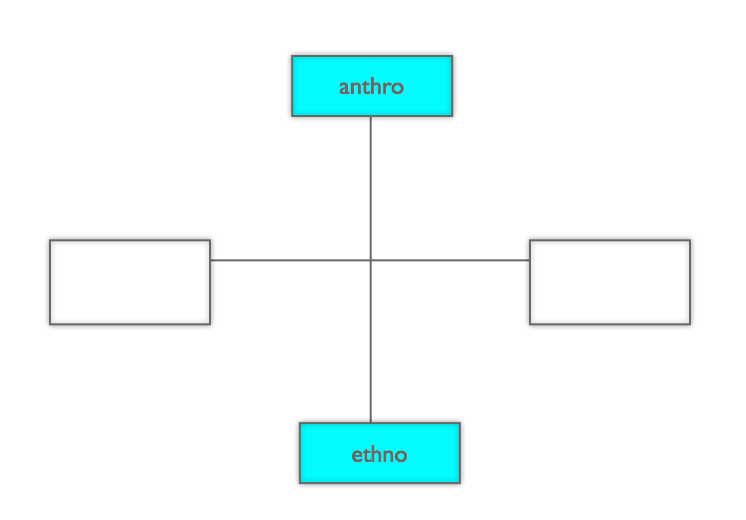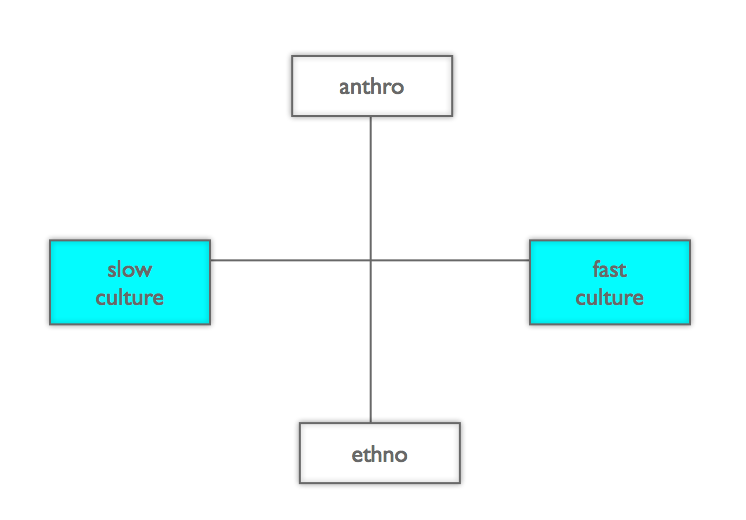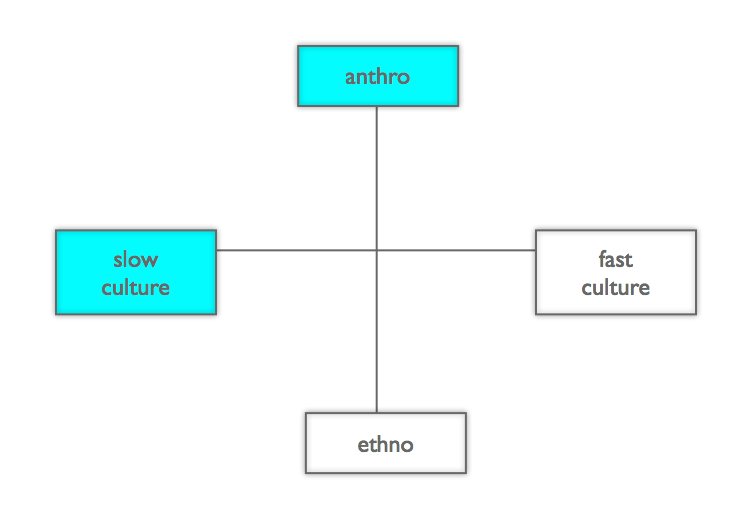
Ethnography has grown in the last couple of decades from a moody, friendless method in the social sciences to the belle of the business ball.
But clearly it has suffered in this rise to stardom. In the wrong hands, ethnography is now a license for the methodologically slap dash. To use the immortal words of Errol Morris, ethnography is now sometimes “cheap, fast and out of control.”
Part of the problem, I think, is that ethnography has been shorn away from anthropology. It was created by anthropologists (and to a lesser extent sociologists) and used in conjunction with anthropology (or sociology).

The advantage of adding “anthro” to “ethno” is that it allows us to put things captured in the life of consumer, user, or viewer in a larger, illuminating context. We can see, more surely, what it means. Without this larger context, ethnography devolves into simple observation, as in “this is what I saw when I was in a consumer’s home.”
Adding “anthro” to “ethno” also give us access to theoretical resources and intellectual traditions that contemporary ethnographers rarely seem to bring to bear on the problem at hand. (And I’m sure that I don’t need to say that the “problem at hand” for any ethnographer studying the ferocious dynamism of contemporary culture is usually formidable. We need any and all the powers of pattern recognition available to us. Airily dismissing the patterns made available by intellectual discipline and years of theoretical development is just dumb.)
How can we tell that someone is adding “anthro” to “ethno?” We are entitled to ask “where did you study anthropology?” (We could also use “sociology,” “film studies,” or “American culture.”) We are asking, “what do you bring to the table beside a claim to method?”
But this is only part of the problem. Too often, the researcher has no “depth of field.” He or she is incapable of seeing that this family, this home, the user, this community is a creature in motion changing in real change. Good observers have an acute sense of the historical factors at work here. They know what has happened in a very detailed way since World War II and they have a general sense of what has been happening in Western and especially American culture over the last 300 years.

This gives us a glimpse of “slow culture” as well as “fast culture.” (For more on the distinction, see my Chief Culture Officer.) And now we are really testing the abilities of the self appointed ethnographer. Do they have depth of field? Now we are entitled to ask, “tell me about any big, enduring trend in American culture. How did it take shape over time?”) (Don’t be surprised if they are astonished by the question.)
Here’s the problem. Most of the work being done by ethnographers is being done here.

But this ethnography is stripped of the things that gives it real explanatory power.
What we need is something that heads in this direction.

If ethnography is to evolve, we want to migrate in the direction of “anthro” + “slow culture.” We could think of this as a “Northwest passage” strategy. Until we find a way to connect these worlds, the Southeast sector must remain poorer and less cosmopolitan.
It’s not clear to me what the practical solution is. I did a couple of posts about the C-school idea a few years ago and discovered some of the following programs, any one (or several) of which might take up this challenge. (Notice that I am not saying these places have a solution, merely that they are the kind of places that might come up with one.)
The D school at Stanford (David Kelley)
W+K 12 (Wieden + Kennedy school, Victor a German Shepherd pointer)
The Miami Ad School (Ron & Pippa Seichrist)
The VCU BrandCenter (Helayne Spivak)
The Berlin School of Creative Leadership (Michael Conrad)
EPIC (Ken Anderson and Tracey Lovejoy)
UC Berkeley School of Information (AnnaLee Saxenian)
California College of the Arts
Royal College of Arts
MIT Media Lab
Rhode Island School of Design
IIT Institute of Design (Laura Forlano, thank you Sergio)
Ethnography Training (Norman Stolzoff and Donna Romeo)
Consortium of Practicing and Applied Anthropology
Ohio State (Liz Sanders)
University of North Texas
Wayne State
Columbia Business School (Bob Morais)
Fordham Business School (Timothy Malefyt)
Savannah College of Art and Design (Sarah Johnson and Susan Falls)
As I was noting here, the Annenberg School at USC is coming up fast.
Finally, I recently had lunch with John Curran and he tells me that things are afoot in London. I will leave it to him to reveal the details. (John, please send me a link so that I can include it here.)
I am hoping readers will let me know the programs I have missed.
Laura Forlano at IIT Institute of Design 🙂
Sergio, so noted, thanks!
Grant, you might want to consider Liz Sanders at Ohio State and PJ Stappers at TU Delft, as well as Bruce Hannington at CMU. Both are teaching design research at a pretty advanced level and might take on this challenge. As my email to you just now via Linkedin says, I’ve been endeavoring to cover this in my courses at ArtCenter, and this article gives me inspiration for some tweaks I’m going to make for next term. Thanks!
I agree you might want to consider Liz Sanders at Ohio State, Christine Miller at Illinois Institute of Technology (formerly at Savannah College of Art and Design), Sarah Johnson at Savannah College of Art and Design. In general more and more design schools focused on strategy and innovation are incorporating anthro/ethno studies.
hinashahid, thanks, so noted!
What do you think about the opportunity for the academic side of things (anthro + slow culture) to evolve towards the professional and business side of the diagram? After all, that’s where you came from, right? That’s been my experience, as well, for better and/or for worse. I also recently had the opportunity to attend the SfAA conference for the very first time and while I can’t vouch for much of what was going on there, it was interesting to see a contingent of business anthropology emerging in the applied anthropology world—UNT might be a good case in point, as they are beginning to work on design problems as of late. I don’t know, is this exciting times for the discipline, or do we have a very long way to go and we’re too flat-footed? As much as I want to be an optimist, I vacillate on the answer to that one.
Great post, Grant. Add UNT and Wayne State. I’m teaching along these lines at Columbia Business School and Timothy Malefyt is doing so at Fordham Business School. And see our book, Advertising and Anthropology. Sunderland and Denny have also discussed the need for anthropology in marketing ethnography, and check this out: https://www.epicpeople.org/standards-of-practice-for-ethnography/.
done, done, and done. thanks!
Two words: cultural anthropology <– they've always been right there but ethnography — as a convenient shorthand — in the 'wrong hands' loses the core of its roots.
As a practicing design researcher (and trained sociologist) I am forever tackling the challenge of explaining to my clients how and when ethnography is appropriate as a method. Often, the allure of contextual research is what is driving the request, but without proper consideration to what design questions are in need of exploration it may not always be the right tool. Furthermore, the emotional experience is often overlooked by practitioners today and should be leveraged as a way to understand both the slow and fast culture of a product/service/interaction/environment.
Thanks for the shout out to OSU, Liz Sanders! Please consider the work of Jon Kolko at Austin Center for Design as well.
Graduate programs in Transdisciplinary Design at Parsons as well as their programs within their urban studies/planning group like Design and Urban Ecologies. These fall under the School for Design Strategies at the New School, where cross disciplinary methods are increasingly part of both graduate and undergraduate curriculum.
I’d also like to add the University of Copenhagen’s MACA program (I am a proud alumna and now teach the course as part of my PhD obligations). We have been working with ‘business-centered anthropology’ with an emphasis on cultural-historical perspectives since 2008. 🙂
http://studies.ku.dk/masters/applied-cultural-analysis/profile-and-career/